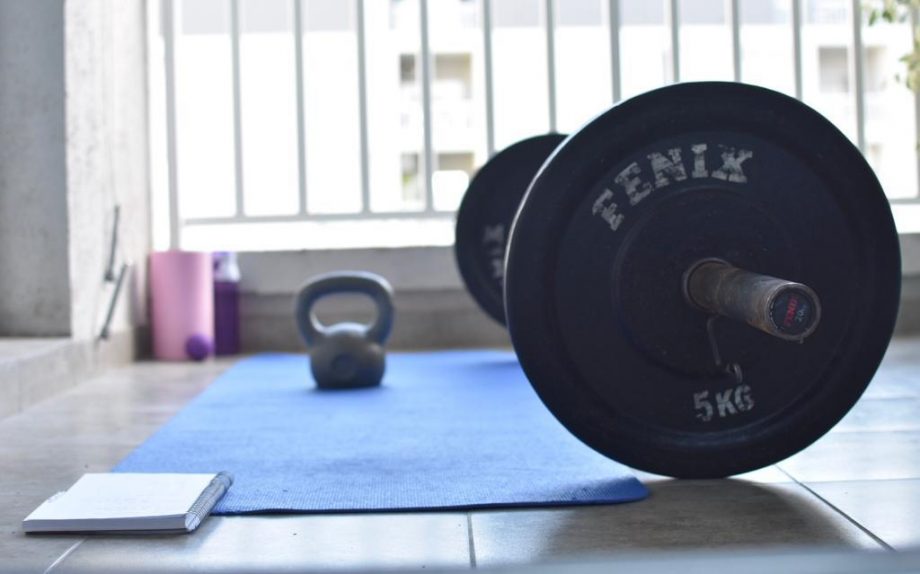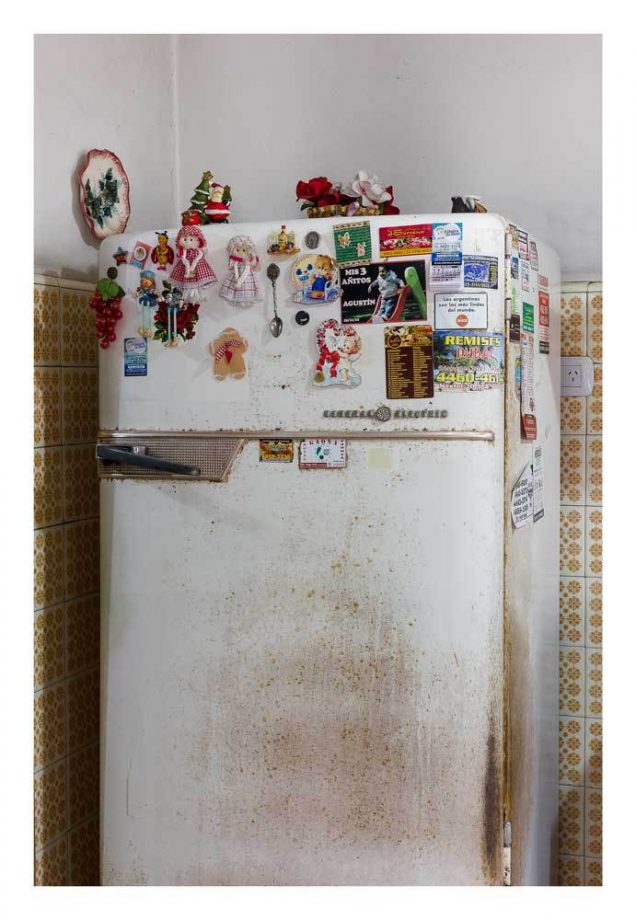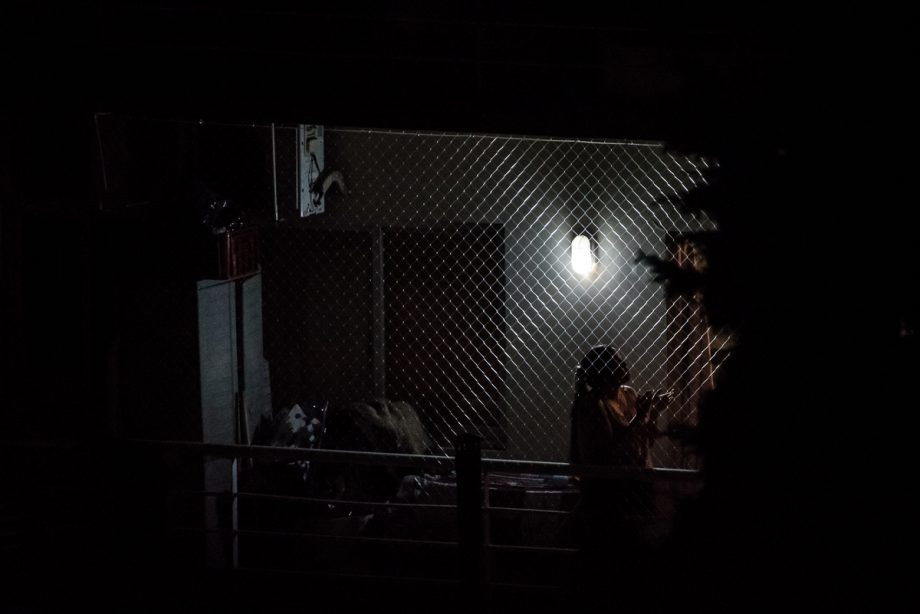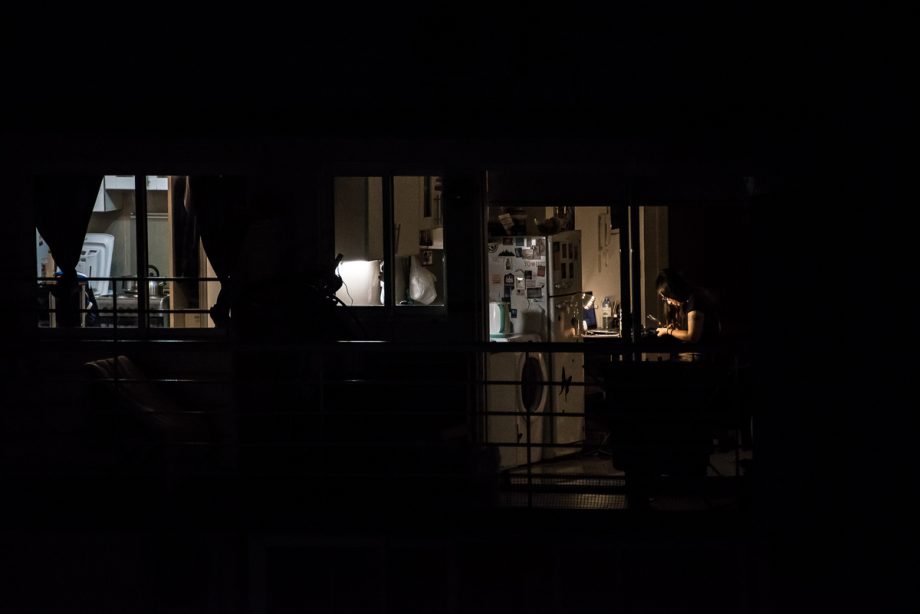Versatile Houses and Flexible Bodies in Times of Coronavirus in Buenos Aires
We’re social scientists. We study practices and imaginaries around the body and the spaces that urban middle sectors inhabit. Isolation brought back questions and we returned to our fieldwork[1]: What becomes visible in this new context? How do we experience and articulate our bodies in our homes?

Gym at home. Copyright: Valentina Hijós (IG: @valenhijos). Reproduced with permission.
First, the suggested confinement and then, the mandatory confinement began to disrupt the ways we live[2]. For those who were transitory in our homes, it made us inhabitants, for whom the house was our refuge, now it is also a place between the unknown and the asphyxiating. The house and the body are the protagonists of isolation. Wrapped up in uncertainty, we are forced to adapt and reconfigure ourselves. Suddenly, the house is presented as an uneven stage of corporal and reflexive experimentation. Taking care of the body in confinement is shown as a challenge, an odyssey and another duty: to take care of one’s body in order to feel pleasure and well-being. Not all bodies are the same, nor do they all find enjoyment in the same way: we find bodies that are quieter, more sedentary, there are activities that cannot be chosen or postponed, routines that are not done as before, and family upbringings require greater attention and end up placing a heavier burden on those who perform such role. Wishes collide with moral walls that delimit what should or should not be done. We fix or maintain the house at the same time as we find ourselves. Confinement makes our home a temple to be preserved as the body is. Such a pattern of caring for the body extends to and reaches the house. Connection, care and balance become a key triad to sustain the isolation. Spaces are transformed, efforts are multiplied, with the aim of participating in workouts, now online. Gym chain videos are exploding with Zumba and Hiit Box classes encouraging those who were previously inactive. Runners racing in one-room apartments show off their skills. Those who reaffirmed their identity through exposure to risk are the stars of the news today: amateur athletes -without limits- who complete 42 kilometres on 7 m² balconies, cyclists who violate quarantine and are filmed pedalling in the mountains, influencers and communicators who finish triathlons in their backyards to encourage the awareness of staying at home. Amateurs sign up for virtual competitions to encourage movement and feel a community. Physical training offers us relaxation, escape and a liberation of endorphins, but, at the same time, it is a way to position ourselves competitively: not to lose the status we have reached, to demonstrate our “self-management”, our will strength and improvement.
The new modalities of communication and transmission (the platforms, the Instagram lives, the YouTube tutorials, or the parodies in TikTok) place us in front of a supposed democratization of the contents. The logic of “do it yourself” (now “at home”) seems to deepen and take shape in times where access to services is restricted and we end up becoming a bit of masters, cooks, psychologists and coaches. People share experiences on how to create an environment to exercise or meditate: moving a piece of furniture to gain space, using a blanket instead of a mat, creating a climate with incense or candles, are some of the tips to “set the mood” in that house that we have turned into a Multipurpose Room. A way to canalize the anxiety of an uncertain future. A way to cultivate sensitivity through one’s own skills is a mode of waiting, with confidence and optimism, for the pandemic to pass. We hear that spaces are more “friendly” if they have natural light or that they are more “livable” if they are versatile and have good ventilation while others see their living conditions threatened. This pandemic reinforces inequalities of those who either cannot “stay at home” or are left in overcrowded housing conditions where basic services are not covered. Even the differences are all crossed by a system that requires us to do. It is an overwhelming invitation that appears in the form of tips on social networks, under a performance command. Productivity and self-governance intersect with the fear of getting fat or “losing physical shape” as undesirable effects of quarantine. Advice guides for “taking care of yourself”, make-up, online recipe books, caloric regulations, ‘fitfluencers’ and cooking influencers sponsored by quasi-nutritionists fill the digital world. The fridge becomes an artifact to keep away from.

Identity frames at home. Copyright: Fernando Javier Blanco Esmoris (IG: @fer_con_f_de_flow ). Reproduced with permission.
Bricklayers and decorators are consolidating themselves as ‘buildfluencers’ while teaching us how to match who we are with our houses. The streaming transmissions saturate us in front of a time and space that we no longer feel as our own. There are no schedules when everything can be done at any time. The everyday rhythm we used to have is permanently broken when a family video call surprises you while you’re taking a Twerk class or listening to your college professor. The times overlap. How do we deal with the hyper-availability of offers that overwhelm our bodies and spaces? We can do it all. The supposed autonomy drives us to rethink -for example- the ways we move and do sports today: books, rice packages or jerry cans are alternated to do exercises with weight.
While we are training, some of us choose to show us where they live, their patios in the size of a sports hall. Before the spaces of sociability were on the outside (the school, the office, the gym, the square), now the house is shown from the “inside”, from the living room. We build an environment that, in some way, will be displayed or exhibited: to family, teachers, friends or others. The house is now produced in conjunction with the many outdoors. The Argentinian anthropologist, Paula Sibilia (2008), would have called this an experience of extimacy. The idea of making intimacy external, seems to be the great protagonist of the contemporary scene, accompanied by the different ways that the self is assumed. A kind of narcissism is in the air, leading to societies that privilege some appearances. In this new show, the domestic landscape is condensed into objects such as dumbbells, sanitizers and repellents[3]. The spaces become more versatile and flexible. The elastic capacity of our houses and our bodies is assumed. Availability is experienced as an individual mantra. Faithful to the pattern of neoliberalism that proposes that we be prepared for “any situation”: be managers, entrepreneurs, resilient, that we develop from disastrous events, that we have adjustment strategies and that we value risk positively. What niches of certitude do we develop in the midst of this isolation?
To be “always ready” became a form of existence. At times it seems that we are returning to a state of nature, where the threat constitutes the environment. During this wave, we are asked to endure, to yield, to be the architects of the answers, of the solutions. The entrepreneurial spirit drives us to make this a new opportunity to test ourselves, to resignify the risk. The language of coaching filters words and instructions into different areas and homogenized experiences. “With what you have, you do”, proposes a gym teacher at Instagram, while she encourages people to follow her fitness classes with water bottles. A decorator tells us “The one who wants can” during her explanation on how to skate a piece of furniture. In a virtual meditation we are invited to align our chakras: “Listen to your body and give it what it needs”. Blossom into chaos. Reinvent ourselves, design ourselves, and exploit the opportunities that disorder creates. Maintain the attitude of being prepared. Put up with everything, tolerate without collapsing. The normative ideal of neoliberal capitalism is diluted in a phenomenon that intervenes in four dimensions: language, space, body and emotions. The French philosopher and sociologist, Gilles Lipovetsky (1986), would say that this narrative produces a semantic lifting. That is, we increasingly use equal terms and slogans to refer to the same things: we make use of concepts that are based on growth, harmony and respect.
The Argentinian President Alberto Fernández criticized this neoliberal preaching when he said a few days ago: “The postmodernism made us believe that the secret was individualism” (“El posmodernismo nos hizo creer que el secreto era el individualismo”)[4]. “No one comes out a champion alone” (“Nadie sale campeón solo”) announces a video released by the Argentine Football Association (AFA), the governing body of this sport in the country. The prevailing individualism is being eroded by institutional messages. In this scenario, solidarities appeared. “Do you need help? Shall I do your shopping?” says a sign posted in a building’s elevator. Coming home is a coming back to ourselves but also a need to help others.
Today, as older adults are at-risk groups, networks and proposals for cooperation among neighbors are being activated. In moments of social isolation, the intention to feel that we are all together is amplified. Going to the supermarket or the pharmacy for someone who cannot go out, inhabiting the balconies, looking at ourselves from some distance, singing the hymn.

Confinement. Copyright: Santiago Joel Abdala (IG: @sjabdala). Reproduced with permission.

Confinement. Copyright: Santiago Joel Abdala (IG: @sjabdala). Reproduced with permission.
Ways of solidarity are arranged digitally through Whatsapp channels. Volunteer initiatives organized by local, provincial and national governments are articulated as a response to isolation. The mutual help is palpable even in digital posts. We see actions of reciprocal help, contacts and collective micro-organizations. Bodies are still knotted up in their inequalities. In moments of crisis we find different forms of solidarity: a more individualizing one -signed by the context in which we live-, linked to recognition and positioning. As a form of on-demand altruism. The same people who join in a type of individualizing solidarity are those who moralize their neighbors for going up and down the stairs or for using the terrace for gymnastics. In this context, the risk lies in confusing care and solidarity with control and denouncement. “Don’t be a cop, don’t report it,” say some neighbors in an apartment complex. The more they have, the more they applaud: either to recognize the health workers – the most exposed in this crisis – or to protest with nightly pots and pans[5] under the slogan #PolíticosBajenseLosSueldos, demanding that politicians lower their salaries. Paradoxically, those who applaud adhere to a type of request that does not move the state’s collecting needle to make public policies that help everyone. However, they are the first to criticize the wealth tax. Paradoxes are also embodied in this kind of individualized solidarity. This crisis reveals how poorly paid the essential professions are, those that will save us from the expansion of the COVID-19: although showing social recognition, the applauses will not put more money in their pockets.
In this pandemic, we also find other initiatives organized communally, as expansive forms of networking, which do not have to do with a logic of immediate giving and receiving, but instead are inserted in a type of circularity of aid, where the greater good prevails. Funds are collected either in the form of money or non-perishable provisions to build up sacks of food and essential goods all over Buenos Aires province. It is not only a matter of gathering goods but also of joining articulated efforts and tasks. Those who are involved in such activities devote time and body to these initiatives. Shipments and deliveries are made to the families’ houses, the community canteens fill the tuppers with stew. There are local organizations that use their facilities to respond to both health and social demands, fulfilling a care function.
In this text, we present various sides of the experience of mandatory isolation in Buenos Aires (Argentina) after the pandemic caused by COVID-19. On the one hand, an advance of neoliberal preaching and an exacerbation of “do it yourself” now “at home”. Where a process of extimacy is expanded and finds in the house the privileged environment. On the other hand, we find institutional, communal and individual responses to this gradual fragmentation that are materialized into various forms of solidarities. In particular, we present two: one individual articulated in a give and take of favors and the other organized as a circular exchange of efforts, goods and tasks. What type of solidarity will arise from this pandemic after all? If solidarity actions are translated into communal terms, at the end of the quarantine, which communitas will prevail?
Written on 06. April 2020, revised 09. May 2020
María Florencia Blanco Esmoris holds a Bachelor’s degree in Sociology from the Institute for High Social Studies (IDAES) of the National University of San Martin (UNSAM). She is currently pursuing a Ph.D. in Social Anthropology at IDAES-UNSAM, where she also serves as Assistant Professor. In addition, she is a Lecturer in Anthropology and Sociocultural Problems at Universidad de Belgrano (UB). She is a fellow of the Argentine National Council for Scientific and Technical Research (CONICET) at the Center for Social Research (CIS) / Institute of Economic and Social Development (IDES). Florencia co-coordinates a research group related to daily lives and materiality at IDES and is also a member of research groups connected to intimacy and urban studies at IDAES-UNSAM.
Find her on twitter and IG: @florabsas. Email: flor.blancoesmoris@gmail.com
Nemesia Hijós holds a Bachelor’s degree in Social Anthropology from the University of Buenos Aires (UBA) and a Master’s degree in Anthropology from the Institute of Economic and Social Development (IDES) – Institute for High Social Studies (IDAES) of the National University of San Martin (UNSAM). She is currently pursuing a Ph.D. in Social Sciences at UBA where she also serves as an Assistant Professor. She is also a recipient of a doctoral fellowship from the Argentine National Council for Scientific Research (CONICET). Nemesia is a member of research groups related to football, politics, and sports in general at the Gino Germani Research Institute (IIGG).
Find her on twitter and IG: @nemehijos. Email: nemesiahijos@gmail.com
Footnotes
[1] We study practices and imaginaries around the body and the spaces that urban middle sectors inhabit. Although the article was written jointly using the first person in plural, the two ethnographic experiences arise from our own individual researches: the one linked to the body and sport practices is derived from the work of Nemesia Hijós with runners and amateur athletes in training groups, and the one referring to the house and ways of living in Haedo (Province of Buenos Aires) is based on María Florencia Blanco Esmoris’ research. We recognize ourselves as part of the socio-cultural universe we study. For this reflection we use field notes taken in March and April 2020. In this text, quotation marks will be used to highlight terms that are meaningful to our interlocutors. They are either linked to the body or articulated with the house.
[2] On 20 March 2020 at 00hs Argentina began a mandatory quarantine established by the National Decree 297/2020. Since then the Decree has been renewed every fifteen days with minimum flexibility in accordance with needs of force majeure, be they of a health, economic or social nature. About this: “… it is established the prohibition to move by routes, ways and public spaces, in order to prevent the circulation and the contagion of the virus COVID-19”. (own translation). Citizens are only able to make minimum and essential trips to stock up on cleaning supplies, medicines and food. Source: http://servicios.infoleg.gob.ar/infolegInternet/anexos/335000-339999/335741/norma.htm
[3] At the same time that the pandemic is developing in Argentina and the world, in our country the cases of dengue fever continue to increase strongly in metropolitan areas.
[4] This phrase was said by the President at the opening ceremony of the “Sanatorio Antárdida”. Source: https://www.youtube.com/watch?v=g1q91hsCm2U
[5] Pots and pans (cacerolazos) is a form of popular protest which consists of a group of people making noise by banging their cooking utensils in order to call for attention and claim.
References
Lipovetsky, Gilles. 1986. La era del vacío. Ensayo sobre el individualismo contemporáneo. Barcelona: Anagrama.
Sibilia, Paula. 2008. La intimidad como espectáculo. Buenos Aires: Fondo de Cultura Económica.































